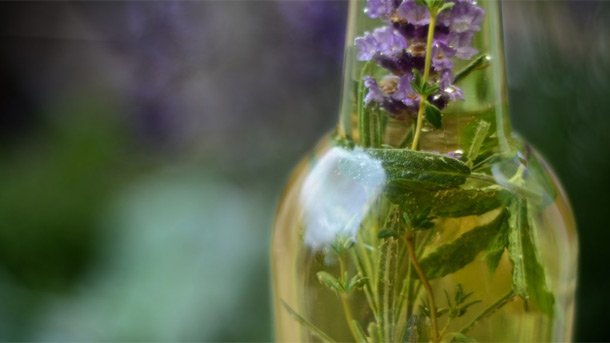Bulgaria is among Top 3 in Europe, regarding the production and export of herbs and it is for sure a leader, as far as the variety of healing plants in our lands is concerned. Our export list contains several hundred species alone. Albania is our main rival with wild herbs, while Poland is the one for cultivated herbs, Mrs. Marlena Stoyanovska, chair of the Bulgarian Association of Herbalists and Mushroom Pickers told a Radio Bulgaria reporter. Despite the crisis, the volume of Bulgarian herbs exported is still going up and amounts to some 15,000 tons per year. If we add spices and herbs to that we will go to some 20,000 tons. The export is gradually expanding in terms of geography to North and South America. A recent breakthrough has been registered on the Egyptian market too. Our main herbs are lime, nettle, thyme, mint, melissa and coriander. Bulgaria has pushed away France for some years as a leader in the export of lavender. The growing of roses still remains essential for this country. Our No 1 position in the export of rose oil is being competed by Turkey only. The quantities of wild herbs has almost equaled the cultivated ones over the years, as the biological and biodynamic methods are being implemented more and more.

© Photo: BGNES
We remind all this due to St. John’s Eve /the night of June 23/ that has been marked as herb fest across these lands since ancient times. People’s beliefs say that the healing power of herbs reaches its maximum during the days around the summer solstice. Many use to go for herbs in the morning of this day even nowadays. The Etar Ethno-Architectural Reserve in the Balkan has been traditionally the center of the festive celebrations. A contest for the most beautiful wreath of “77 and a half herbs” took place there this year too on June 23. The plants were wrapped around a mulberry sprig with a diameter, allowing a person to go through its center for health, following the tradition. The resurrection of ancient herb medicines were a curious moment, as famous Bulgarian herbalist Emil Elmazov, chair of the Union of Herbalists in Bulgaria was the medicine man once again. The first demonstration medicine had the curious name Balm of Four Thieves.

© Photo: BGNES
“That was the medieval cure for the most serious infections in Europe,” Mr. Elmazov explains. “It takes us back to the 14th century, when plague raged across Europe, called the black death. Entire cities were depopulated and thieves appeared, who invaded the abandoned houses. Four of them got caught and when the judge asked them if they were not afraid of the black death, they said they had a medicine, trading this way their life for the recipe. We showed how the cure was prepared – with the usage of a handful of lavender, rosemary, salvia, wormwood and rue, which are poured in a pot with two liters of really strong vinegar. This all has to stay a couple of weeks in the sun. Then the liquid is filtered in bottles with a piece of garlic in each of it. When the liquid settles down, only the upper part is poured in another bottle, where it can be preserved for ages. Ancient bottles of that kind have been found in caves.”
The creation of the Avicenna’s panacea is another curious moment. According to Mr. Elmazov the unique medicine of the ancient doctor is similar to the recipes of the Bogomils, the medieval heretics, who worshipped the healing abilities of nature.
“We have serious proofs that the panacea existed with the Bogomils too, who were later expelled from Bulgaria. We know the Avicenna visited the Balkans back then. On the other hand the relation between the Eastern and traditional Bulgarian medicine can’t be doubted,” Mr. Elmazov says. “Here is how Avicenna’s panacea looked like according to him: fresh leaves of rue and willow were mashed with a wooden spoon in a glass vessel and then very old, true wine was poured over those. The medicine provides vitality and its impact is at many levels, both physical and mental.”

© Photo: archive
St. John’s Eve is now traditionally marked in the old capital of Bulgaria – the town of Veliko Tarnovo. “We want to show that the fest could be celebrated in city environment too, as citizens shouldn’t remain isolated from the healing power of nature,” Emil Elmazov says. The romantic architecture of the old Samovodska Street is the background of the fest today, June 24. The only one for the moment plant for organic food is to be visited and the new “bear strength” drink, based on blueberries and honey will be presented too.
English version: Zhivko Stanchev
The program of the Orthodox Book Week offers meetings with authors, publishers and translators of Orthodox books from the last few years. The event is held until November 10 at the ''St. Procopius of Varna'' Church, with meetings taking place every..
The "Kabiyuk" horse breeding farm in the village of Konyovets is the oldest stud farm in Bulgaria, founded in 1864 by Midhat Pasha, the governor of the vilayet of Ruse, to produce horses for the Turkish army. The farm existed until the Russo-Turkish War..
There is no exact statistic on the number of Bulgarians living abroad, but a report from the Ministry of Foreign Affairs from last year indicates that around 2.8 million Bulgarians are living outside the country . According to the 2021 population census..
The nature protection organization WWF - Bulgaria is launching a campaign entitled "Subscribe to Nature". The disappearance of wild animals..
There is no exact statistic on the number of Bulgarians living abroad, but a report from the Ministry of Foreign Affairs from last year indicates that..
The program of the Orthodox Book Week offers meetings with authors, publishers and translators of Orthodox books from the last few years. The event is..

+359 2 9336 661
